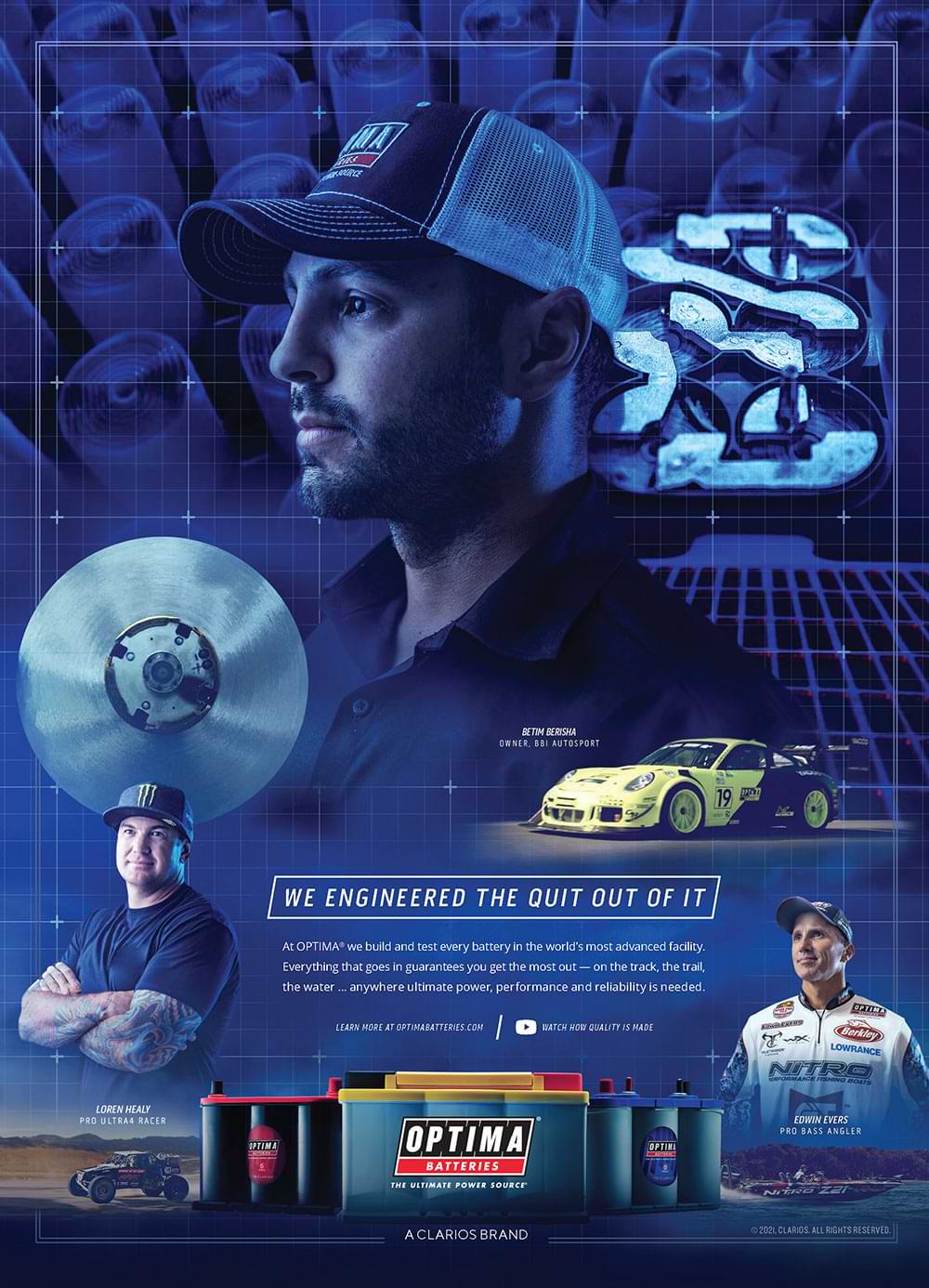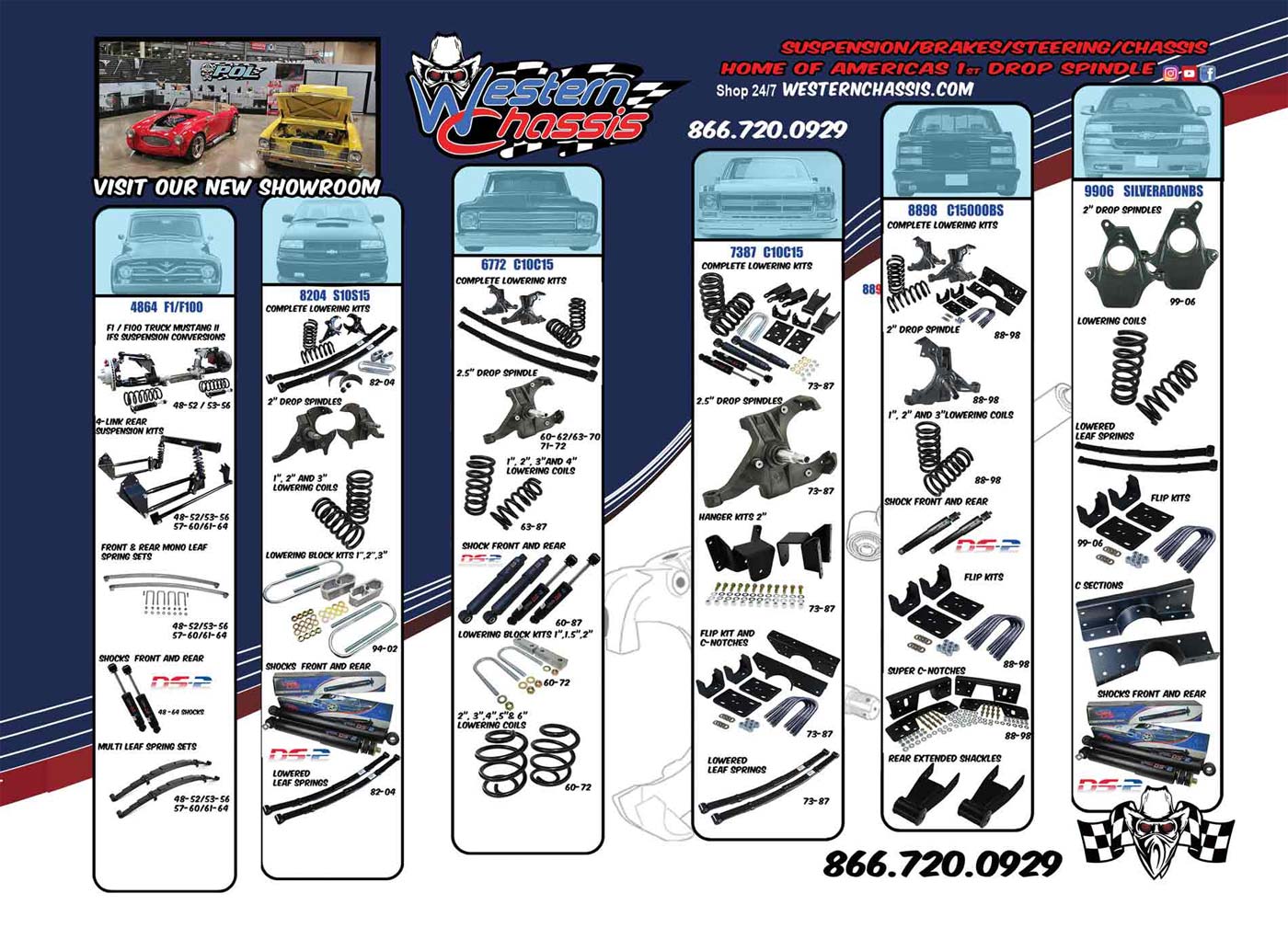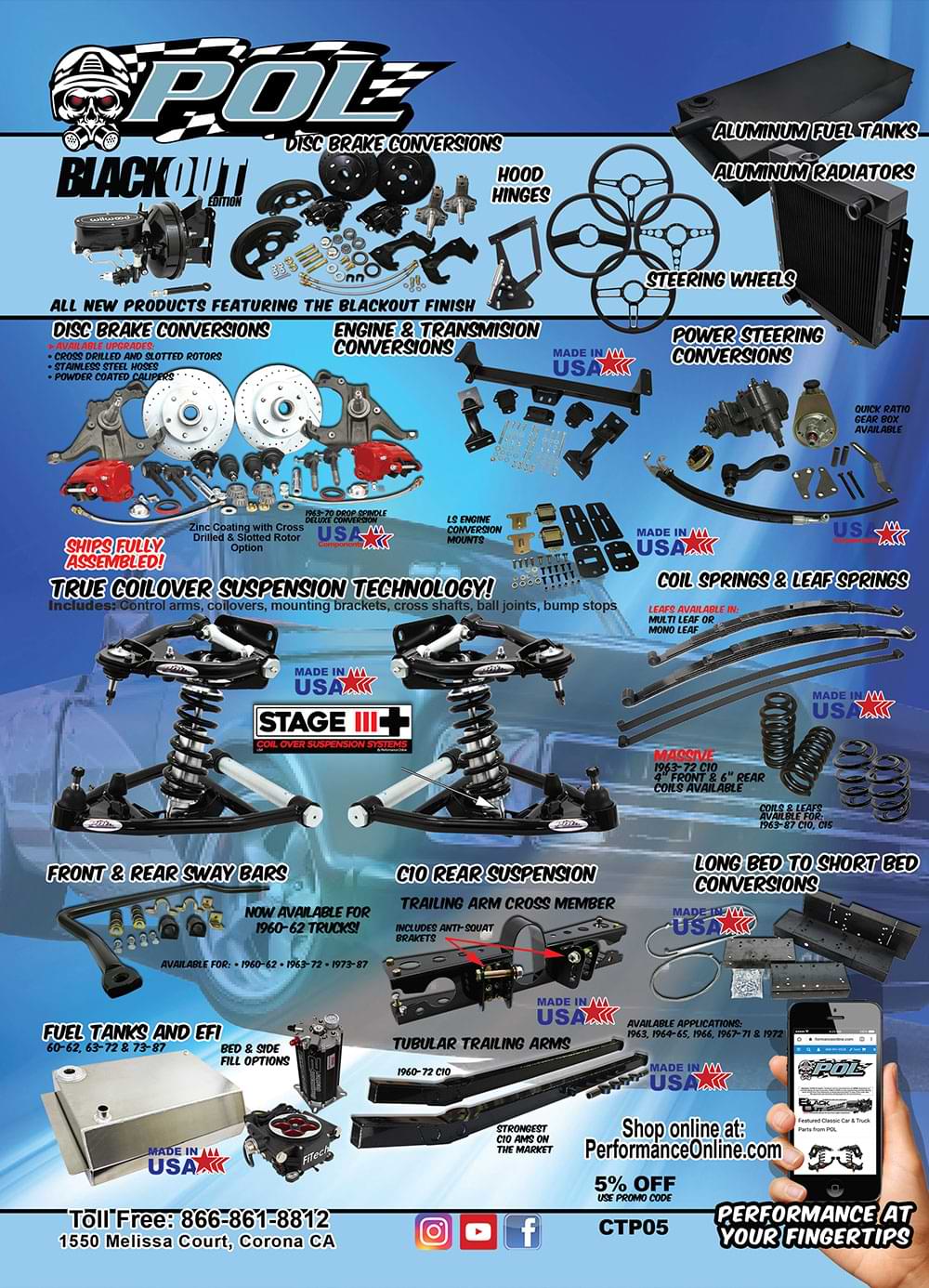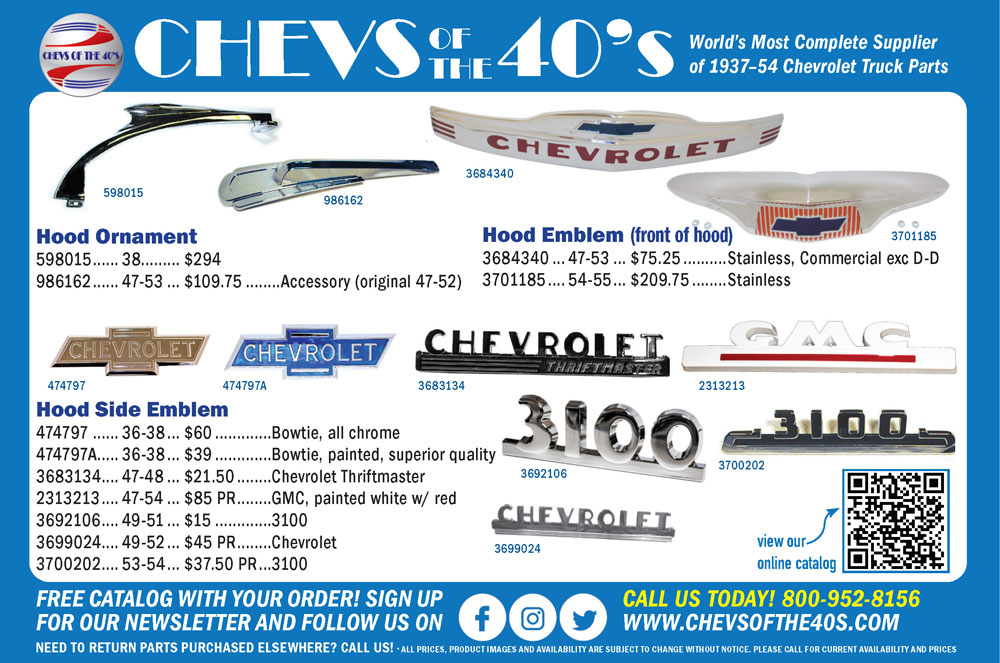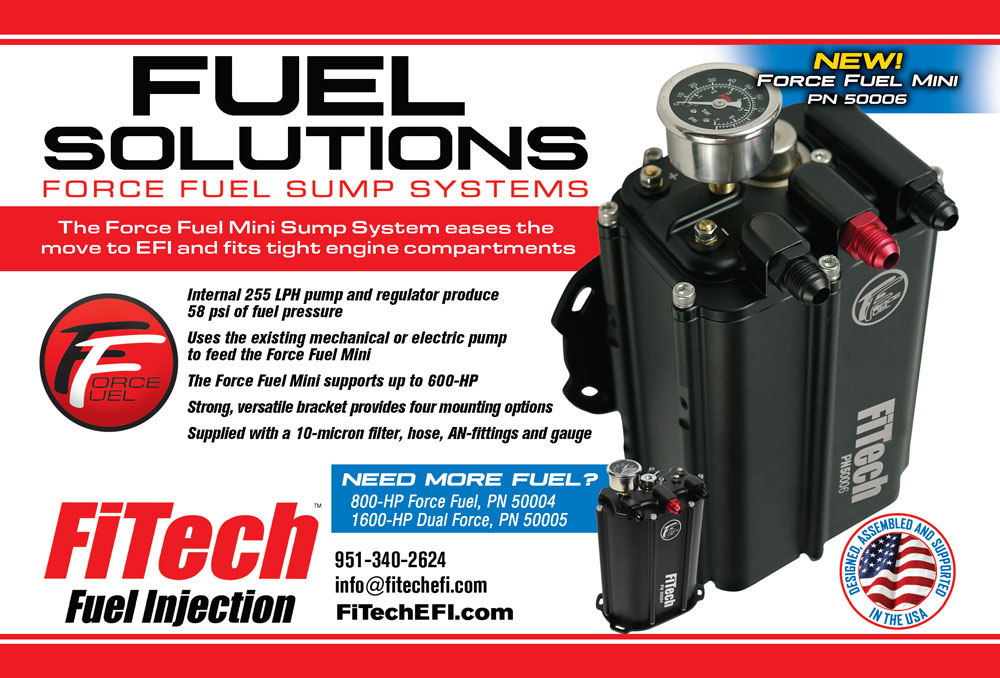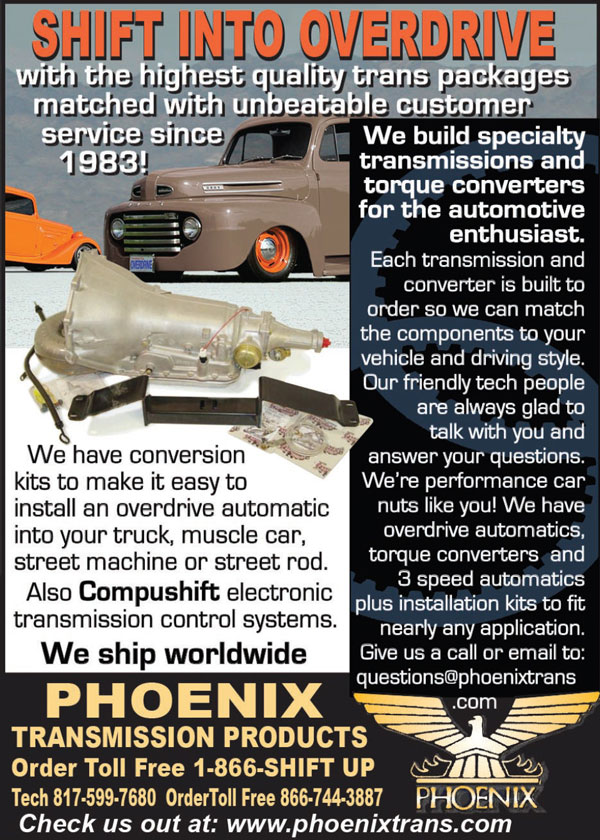
 TOC
TOC Feature of the Month
Feature of the Month
No better place for Tim Sutton to capture Jason Odell’s canyon-carving 1949 Chevy five-window than the foothills of Orange County, California, for our August cover.

ROB MUNOZ
Rodney Bauman, Tommy Lee Byrd, Ron Ceridono, Michael Christensen, Ron Covell, Grant Cox, Dominic Damato, John Drummond, Fuelish Media, Eric Geisert, Joe Greeves, John Jackson, Barry Kluczyk, Scotty Lachenauer, Ryan Manson, Josh Mishler, Todd Ryden, Jason Scudellari, Chris Shelton, Tim Sutton, Chuck Vranas, Michael Yamada – Writers and Photographers
ClassicTruckPerformance.com
ModernRodding.com
AllChevyPerformance.com
InTheGarageMedia.com
Mark Dewey National Sales Manager
Patrick Walsh Sales Representative
Travis Weeks Sales Representative
ads@inthegaragemedia.com
Editorial contributions are welcomed but editors recommend that contributors query first. Contribution inquiries should first be emailed to info@inthegaragemedia.com. Do not mail via USPS as we assume no responsibility for loss or damage thereto. IN THE GARAGE MEDIA reserves the right to use material at its discretion, and we reserve the right to edit material to meet our requirements. Upon publication, payment will be made at our current rate, and that said, payment will cover author’s and contributor’s rights of the contribution. Contributors’ act of emailing contribution shall constitute and express warranty that material is original and no infringement on the rights of others.

PRINTED IN THE USA.
The Classic Truck Performance trademark is
a registered trademark of In The Garage Media.

 Still Hammerin’
Still Hammerin’s of Tuesday, June 15, despite resistance from certain powers that be, the state in which I currently reside—that being California—finally decided to lift restrictions, mandates, and whatnot and once and for all let residents get back some semblance of their former lives. It’s still all pretty surreal, but I’m sure I speak for many others when I say how badly I want to put this last year-plus as far behind us as possible. Sure, it was a tremendous learning experience, and many of the lessons taught and learned will remain with us for years to come and, hopefully, help prevent this from happening again (at least in the severity that it did). But, enough of my soapboxing … let’s get on with it, shall we?
So, as we’ve all seen with regards to the larger indoor car shows (Detroit Autorama, Grand National Roadster Show), we’ve had to make do with smaller outdoor events and local cruises to get our fix, so to speak, for the first couple months of the year. But come March, as witnessed in Texas with the Goodguys Spring Lone Star Nats and other not-so-small shows, things started moving in the right direction. Sure, there were mask mandates and recommendations for social distancing, but that didn’t stop people from doing what they’ve been itching to do for months on end: get outside and drive their trucks!
Here it is late June as I’m writing this, and unlike this time last year (where my event travel itinerary was literally nothing) I’m looking forward to finally getting back out on the road and traveling—beyond the state line! (If you know me, you’ll know that last statement is rather shocking coming from me, as I have an extreme distaste for airports, airlines, and anything that has to do with air travel—so for me to say that, you know I’m tired of being cooped up!) On top of the unusual excitement of returning to some familiar venues, such as Louisville for the NSRA Street Rod Nationals after nearly 30 years of doing so representing the “old regime,” as it were, I’m anxious to attend and represent this brand-new venture of ours.

 Parts Dept
Parts Dept

 Feature
Features much as I love writing about other people and the trucks they build/own and drive, I also love when people have a great story to tell themselves. Not only does it make my job easier, it prevents me from messing anything up. More importantly, it relays the personal perspective just as it was intended. This is Jason Odell’s second 1949 Chevy 3100, and as he’s about to describe, it might just be his last!

 PHOTOGRAPHY BY Tim Sutton
PHOTOGRAPHY BY Tim Sutton

 PHOTOGRAPHY BY Tim Sutton
PHOTOGRAPHY BY Tim Suttons much as I love writing about other people and the trucks they build/own and drive, I also love when people have a great story to tell themselves. Not only does it make my job easier, it prevents me from messing anything up. More importantly, it relays the personal perspective just as it was intended. This is Jason Odell’s second 1949 Chevy 3100, and as he’s about to describe, it might just be his last!


 FEATURE OF THE MONTH SPONSORED BY OPTIMA BATTERIES
FEATURE OF THE MONTH SPONSORED BY OPTIMA BATTERIES
 Tech
Tech
 PHOTOGRAPHY BY Ryan Foss Productions
PHOTOGRAPHY BY Ryan Foss Productionscan’t speak for everyone, but for me the phrase “the one that got away” applies to more than one vehicle, as I’ve let a number of cars, trucks, and even old Harleys go that, to this day, I wish I still had possession of. Whether it was due to a financial need (often to purchase another vehicle!) or an offer too good to refuse, my will to hold on has been adversely tested more often than I care to remember.
While I’ve had the opportunity to buy back a couple of those I regrettably let go, the extremely inflated price just doesn’t always allow it to happen. Fortunately, that scenario recently arose for my publisher, Tim Foss, with an old four-wheeled childhood friend of his—and as he’s about to tell in his own words, this is no ordinary old vehicle, either.
“In 1973 my dad purchased this 1972 F-100 Ford 4×4 pickup, and I loved it. Growing up in the country, at the edge of the desert, I enjoyed borrowing my dad’s truck, having lots of fun desert driving the truck every weekend with my friends. I did this for four years, then in 1976 he purchased a new F-150.
“I was fortunate enough to purchase the 1972 Ford from him, but unfortunately for me, I worked off the purchase with ranch labor in the grueling desert sun. Being that I was only 14 at the time, I spent several long hot summer days of work and every weekend to pay for it. Hard labor worked out and I owned the truck throughout high school and spent a lot of time with it in the Yuma sand dunes and desert.

 PHOTOGRAPHY BY Ryan Foss Productions
PHOTOGRAPHY BY Ryan Foss Productionscan’t speak for everyone, but for me the phrase “the one that got away” applies to more than one vehicle, as I’ve let a number of cars, trucks, and even old Harleys go that, to this day, I wish I still had possession of. Whether it was due to a financial need (often to purchase another vehicle!) or an offer too good to refuse, my will to hold on has been adversely tested more often than I care to remember.
While I’ve had the opportunity to buy back a couple of those I regrettably let go, the extremely inflated price just doesn’t always allow it to happen. Fortunately, that scenario recently arose for my publisher, Tim Foss, with an old four-wheeled childhood friend of his—and as he’s about to tell in his own words, this is no ordinary old vehicle, either.
“In 1973 my dad purchased this 1972 F-100 Ford 4×4 pickup, and I loved it. Growing up in the country, at the edge of the desert, I enjoyed borrowing my dad’s truck, having lots of fun desert driving the truck every weekend with my friends. I did this for four years, then in 1976 he purchased a new F-150.
“I was fortunate enough to purchase the 1972 Ford from him, but unfortunately for me, I worked off the purchase with ranch labor in the grueling desert sun. Being that I was only 14 at the time, I spent several long hot summer days of work and every weekend to pay for it. Hard labor worked out and I owned the truck throughout high school and spent a lot of time with it in the Yuma sand dunes and desert.

 Feature
Feature
 PHOTOGRAPHY BY THE AUTHOR
PHOTOGRAPHY BY THE AUTHORothing helps generate a true appreciation for classic trucks better than spending your formative years with them in a natural environment where they’re being used every day to their fullest extent. For Dave Bartlett of Nantucket, Massachusetts, growing up on the picturesque New England Island created a fusion of history and agriculture for him every day since he can remember. It’s easy to see that his passion for early trucks translated perfectly in the creation of the stunning 1950 Ford F-1 laid out across our pages.


 Tech
Tech Photography & VIDEOGRAPHY BY TAYLOR KEMPKES
Photography & VIDEOGRAPHY BY TAYLOR KEMPKESnderneath a Mustang II or Pinto from where they originated, Mustang II–type spindles are perfect! For decades now hot rodders have been using them with great success under a variety of non–Mustang II vehicles. The potential problem(s) enter(s) the picture when you mix performance-based ½-ton (or larger) trucks and large-diameter wheels with spindles/bearings that were never meant to carry such a, well, heavy load. Under more extreme braking conditions, the spindle “pin” can flex, and with that flex the rotor too will flex, ultimately causing the brake pads to “knock back” against the caliper which, in turn, causes the driver to release and depress the brake pedal to re-engage the pads. This amount of pin flex can vary depending on the quality of the Mustang II spindle, as well as the size of the brakes and wheels/tires they’re trying to stop.

 Feature
Feature
 PHOTOGRAPHY BY Grant Cox
PHOTOGRAPHY BY Grant Coxwentysome years ago, when Oklahoman Jess Steele was in high school, he was fortunate enough to own and drive a 1971 C10. Having parted ways with that truck is something he’s strongly regretted for the past two decades.
Now married and well into a career as an electrical contractor, Jess found himself in the position to get himself back behind the wheel of a 1967-1972 C10. But rather than reconstruct his high school ride from scratch, he took the higher road and instead searched out one that had already been done—or as it turned out, done … with room for improvements to better suit his personal tastes.
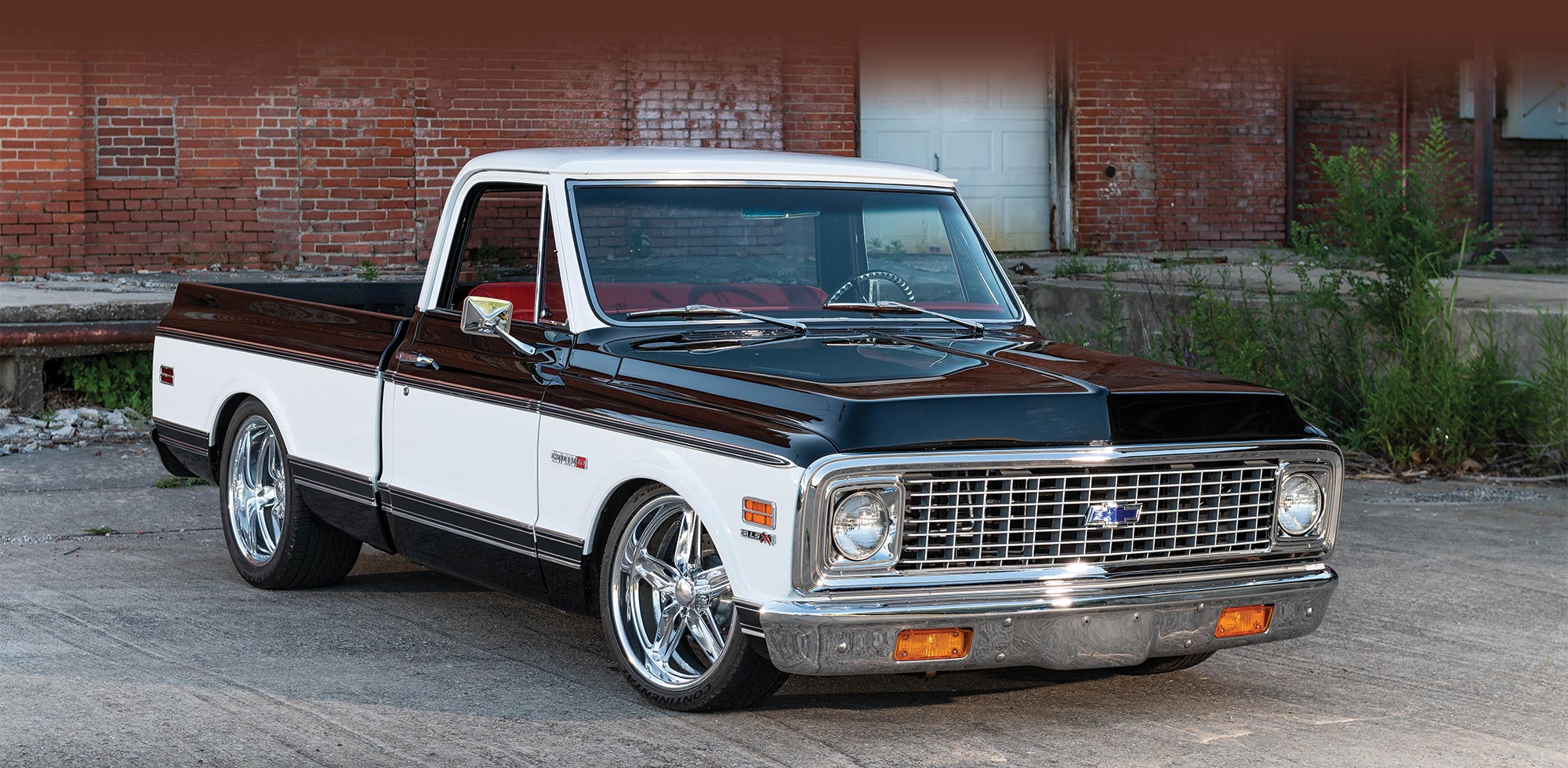

 Tech
Tech
 Photography BY The author
Photography BY The authorow much must we spend to save a buck on body and paint materials? Generics aren’t cheap. The leading brands are just plain spendy, but either way, there are ways to stretch that buck. For savings on body and paint shop staples, it’s largely who we buy from, but it’s also how we care for what we buy.
As a youngster honing the craft that would become a career, I didn’t even know how spoiled I’d become. Back in the ’70s, in Southern California, I had good teachers. In addition there were automotive paint stores with knowledgeable employees who’d help a kid get started. In Riverside we had three such stores at that time. They all ran delivery trucks, but for my own side jobs I’d walk in just to interact with those guys who seemed so doggone cool.
My, how times have changed! At least here in Northwestern Montana, our paint stores are parts stores. That means body and paint materials slide across the same countertop as auto parts, as well as greasy cores. From there it gets worse as the delivery driver checks oil, pumps gas, and maybe munches on a snack along the road to our shop. By the time we receive our greasy goods, they’re seriously contaminated. As a conscientious painter I’m aware of that. If you’re not, perhaps you should be.

 Feature
Feature BY Fuelish Media
BY Fuelish Mediaony Leal’s killer 1964 that you’re witnessing here is the latest of his long line of incredibly built machines. While he has experienced much success with each of the Big Three truck brands, he figured he’d give it another go with a Ford pickup since the last one (a 1961) he built was on the opposite side of the spectrum as this one. It was a patina-clad unibody that he knew deep down he could easily top, even though it was legitimately cool as hell. This time around, he envisioned a superclean, supersmooth Ford that would hit all the marks as a standard cover truck—and then some.


 Tech
Tech
1. The first step when installing any American Autowire harness is to read the instructions. All the individual circuits are bagged and labeled and there are specific directions for each one.

 Photography BY The Author
Photography BY The Authoror many classic truck fans there is nothing more mysterious than an electrical system. After all, how can you understand something you’ve never seen—that is unless you’ve walked across carpeting in your socks, grabbed a door knob, and saw a spark. Of course you don’t have to see electricity to know it exists—if you’ve been zapped by the ignition system of a running engine you know it’s real.
Because of the theoretical nature of electricity it can be hard to know where to start when replacing a dilapidated old wiring harness or wiring a truck from scratch. At one time the common approach to solve either issue involved some sort of diagram, spools of wire (often all the same color, which made troubleshooting impossible), a variety of butt connectors, and lots of electrical tape. The results were seldom satisfactory, often trouble-plagued and sometimes even dangerous. A better, safer, and much easier to install alternative is a complete wiring system like those available from American Autowire. But before we get into selecting a wiring harness there are a few electrical terms you should be familiar with.

 Event
Event

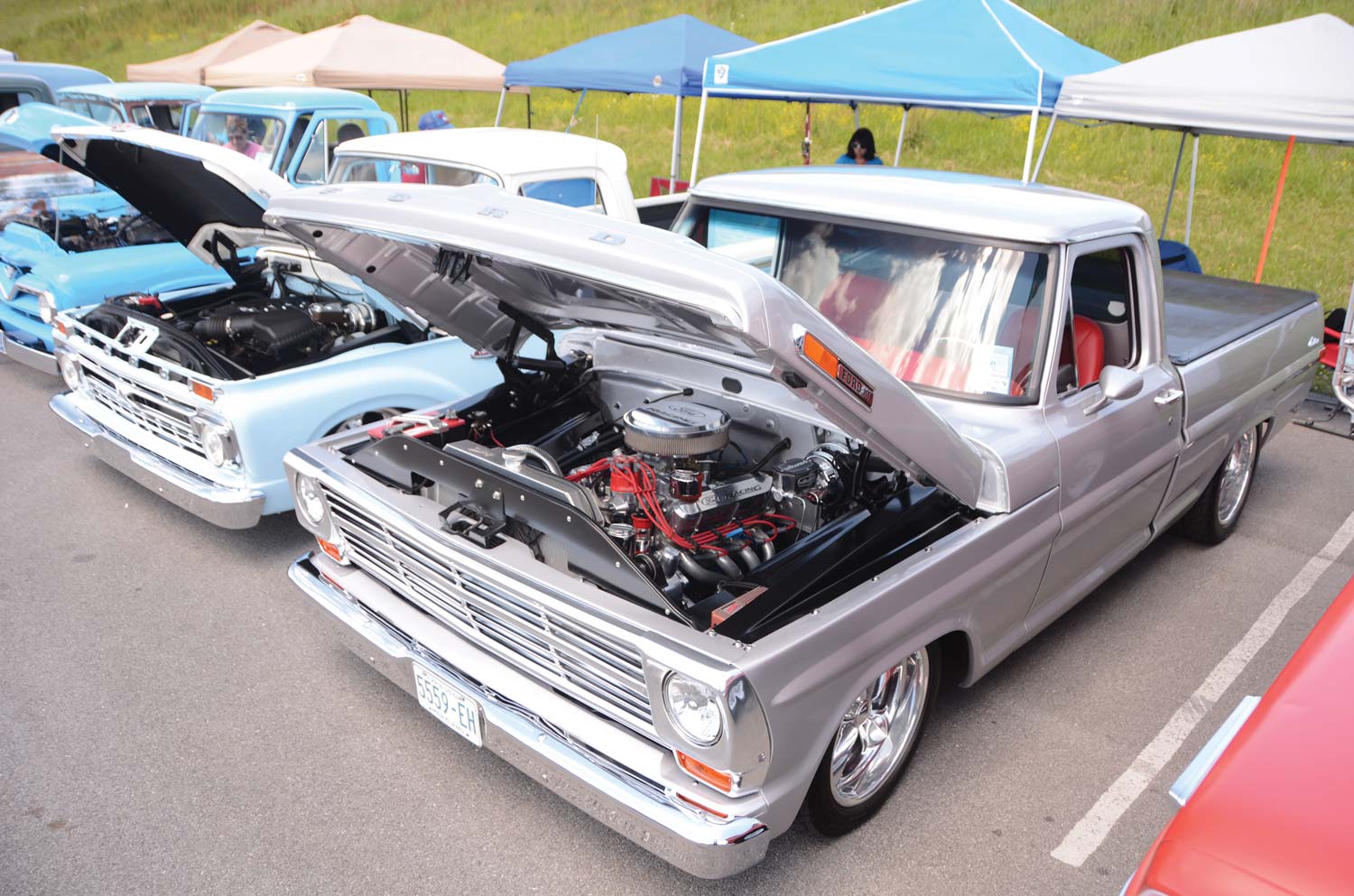
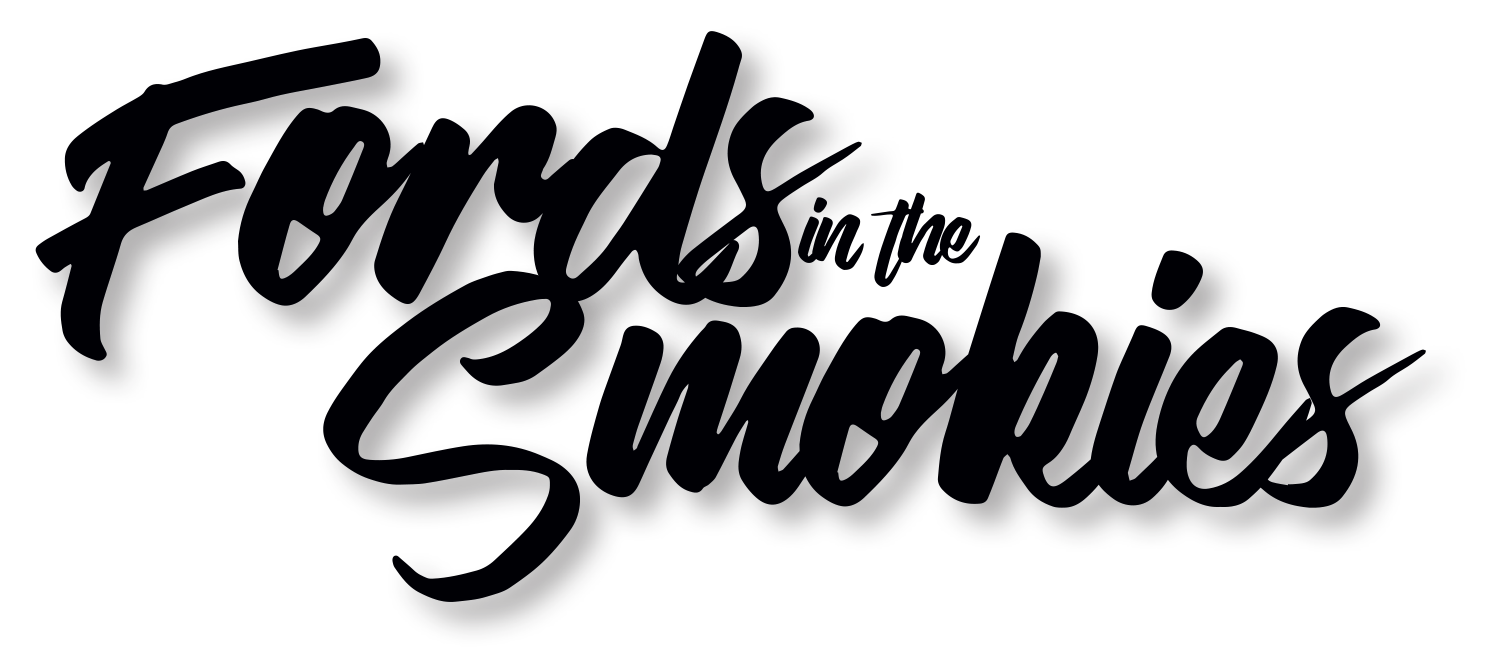
 Photography By THE AUTHOR
Photography By THE AUTHORhen springtime rolls around, the tourist town of Pigeon Forge, Tennessee, buzzes with excitement, as attractions, hotels, and restaurants prepare for their busy season. Part of the action includes the extensive list of car and truck shows that take place in the town, which rests at the foot of the Smoky Mountains. We were fortunate enough to attend the Grand National F-100 Show, an event that has grown significantly in the last few years. It takes place at the LeConte Center, a beautiful convention center that hosts several automotive events each year.

 Tech
Tech Photography BY Mike Chase
Photography BY Mike Chasehen the 1963 Chevy C10 was introduced, it was one of the first fullsized trucks to be offered with a modern, independent front suspension design. While Ford retained its love for the straight axle, albeit upgrading eventually to the twin I-beam design, Chevy opted with a frontend more reminiscent of their passenger car line of the era. The design was a success and one that GM eventually carried on into the ’80s and beyond. Yet while the basic design was a success, especially when it came to easily lowering these trucks, it wasn’t without its faults. The stamped control arms tended to flex under heavy cornering or aggressive driving and a rudimentary lowering job meant the original suspension geometry oftentimes changed, and not for the better. But factory improvements throughout the years meant the early trucks could be easily upgraded with such bolt-in items as disc brakes and power steering, making for a more modern classic truck.
While modern amenities no doubt helped keep these classics on the road, we eventually hit a tipping point where these trucks were being pushed to their breaking point, performance-wise. While the aftermarket industry concentrated on every upgrade imaginable for the muscle car market, our lowly trucks were left with 30-year-old components and technology.
Ad Index
- ALDAN AMERICAN79
- AMERICAN AUTOWIRE49
- AMERICAN LEGEND WHEELS75
- ART MORRISON ENTERPRISES19
- AUTO METAL DIRECT21
- BEDWOOD AND PARTS97
- BORGESON UNIVERSAL CO.73
- BOWLER PERFORMANCE TRANSMISSIONS93
- BROTHERS TRUCK PARTS100
- CHEVS OF THE 40’S71
- CLASSIC INDUSTRIES57
- CLASSIC INSTRUMENTS11
- CLASSIC PERFORMANCE PRODUCTS4-5, 89
- CUSTOM AUTOSOUND81
- DAKOTA DIGITAL99
- DYNAMAT47
- EATON DETROIT SPRING97
- EDDIE MOTORSPORTS61
- FAT MAN FABRICATION87
- FILLING STATION75
- FITECH EFI73
- FLAMING RIVER INDUSTRIES31
- FLAT OUT ENGINEERING93
- GANDRUD CHEVROLET89
- HEIDTS SUSPENSION SYSTEMS71
- HEINZMAN STREET ROD SHOP97
- JOHN’S INDUSTRIES95
- KUGEL KOMPONENTS93
- LMC TRUCK25
- LOKAR2, 29
- NATIONAL STREET ROD ASSOCIATION25
- NOTCHEAD FASTENERS95
- OLD AIR PRODUCTS87
- OPTIMA BATTERIES13
- PERFORMANCE DISTRIBUTORS95
- PERFORMANCE ONLINE55
- PERTRONIX45
- PHOENIX TRANSMISSION PRODUCTS87
- POWERMASTER PERFORMANCE81
- PREMIER STREET RODS6
- ROADSTER SHOP63
- SCOTT’S HOTRODS79
- SHERWIN WILLIAMS COMPANY43
- SPEEDWAY MOTORS37
- STEELE RUBBER PRODUCTS69
- SUMMIT RACING EQUIPMENT7
- THAT’S GREAT NEWS95
- THERMO-TEC AUTOMOTIVE93
- VINTAGE AIR9
- WESTERN CHASSIS27
- WILWOOD ENGINEERING39
Nitroactive.net
Orange, CA
Nitroactive.net
Autobooks-Aerobooks
Burbank, CA
818-845-0707
Autobooks-aerobooks.com
National Speed Center, Inc.
Manchester, CT
860-647-1353
nationalspeed.com
Hot Rod Paper Company
Youngstown, OH
800-676-3026
gadmak@aol.com
Pasteiner’s
Birmingham, MI
248-646-2886
pasteiners.com
Reader’s World
616-396-4600
readersworldbookstore.com
Horton Hot Rod Parts
Ontario, Canada
905-876-2124
hortonhotrod.ca
Graffiti Publications
Victoria 3450
Australia
graffitipub.com.au
One56
Björklinge, Sweden
One56.se















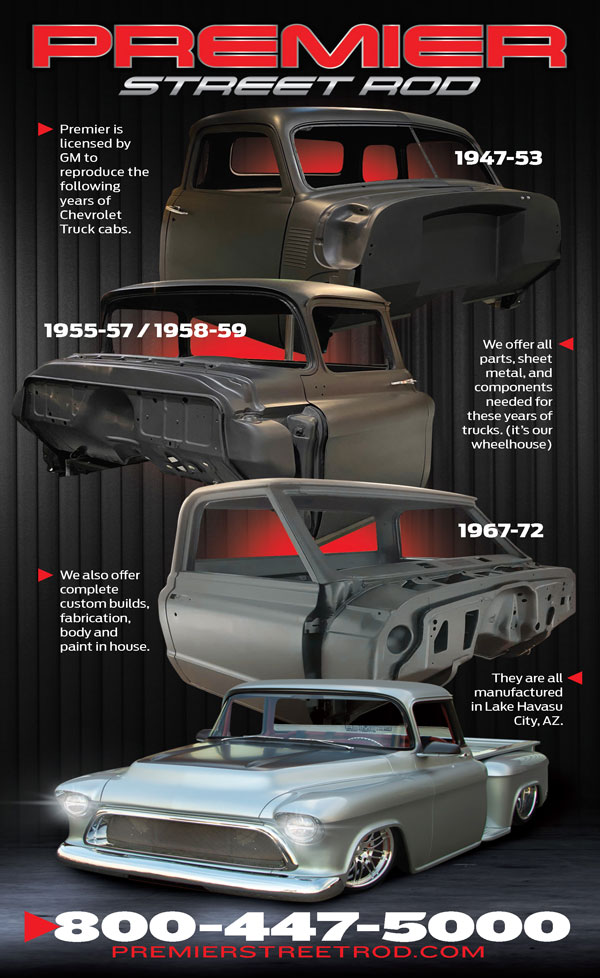



 BY
BY 

